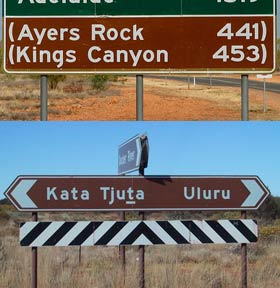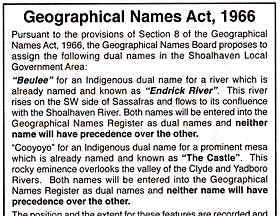Language
Aboriginal place names
European invasion brought along new names for places in Australia. More and more are get their original names back as Australians become aware of their history. Some meanings, however, have been lost forever.

Wishing you knew more about Aboriginal culture? Search no more.
Get key foundational knowledge about Aboriginal culture in a fun and engaging way.
This is no ordinary resource: It includes a fictional story, quizzes, crosswords and even a treasure hunt.
Stop feeling bad about not knowing. Make it fun to know better.
Reclaiming Aboriginal place names

Aboriginal place names are very, very old. Place names were an important part of Aboriginal culture. If you knew the place names and how they connected you could walk the country and orientate yourself. Song lines were a chain of place names.
After invasion many places were named reflecting a story of possession, sharing the tale of territorial conquest, not of the importance of the landscape. Places were named after prospectors, geologists, explorers, royal celebrities and each respective family members. Many Aboriginal place names have been subsequently lost or are in danger of being forgotten.
Since the 2000s more and more place names are being reclaimed and receive back their original Aboriginal name or a dual name, where the Aboriginal name is added to the European name.
The most prominent example is Uluru. Previously known as Ayers Rock its Aboriginal name Uluru was re-introduced on 15 December 1993 with the dual name 'Ayers Rock/Uluru', reversed to 'Uluru/Ayers Rock' on 6 November 2002. The first name of dual names is the official or "dominant" name and should be preferred. [1]
In Sydney, about 100 place names around Port Jackson and Botany Bay were learned from Aboriginal people, but only a few came to be used officially, such as Parramatta, Kirribilli, Bondi, Wooloomooloo, Coogee, Maroubra etc.
Recovering Aboriginal place names is also a vital ingredient to revive Aboriginal languages because in daily conversation places are spoken about quite often, and the Aboriginal word can come easily back into use.
The Geographical Names Board of New South Wales is one organisation helping preserve and promote Aboriginal place names in NSW. Since June 2001 it supports the government's dual naming policy by preferring traditional Aboriginal place names or names with Aboriginal origin wherever it can.
Our naming of our country has simply taken on the names of people, many of whom never set foot on this land. This has limited our ability to properly understand our own storyline, to appreciate the scale of our landscape. We are yet to understand the storyline of our country.
— Ben Wyatt, WA State Opposition spokesman for Aboriginal Affairs [2]
Why some Aboriginal place names are just wrong

Some Aboriginal place names might not even denote the place they label because after federation the interest to add a "distinctive national flavour" to the landscape led to many names being introduced with little regard for whether or not they derived from the locality in which they were bestowed. [4]
For example, the Aboriginal name Katoomba was moved some 15 kilometres to replace the uninviting name 'The Crushers' whilst the true Aboriginal meaning of Katoomba was lost.
Other names refer to people who murdered First Nations people, were involved in blackbirding or supported slavery. One such example is Ben Boyd whose name was given to a national park, roads, a tower and an entire town (Boydtown).
Fortunately there seems to be a tendency to use more Aboriginal place names for new sites, such as the development of the western harbour area in Sydney, known as Barangaroo, which won against the suggested 'Hungry Mile'.
State place-naming policies now favour to re-instate authentic Aboriginal place names. "The use of Aboriginal names is encouraged and the collection and compilation of recorded Aboriginal place names is supported," read the Northern Territory Rules of Nomenclature. [1]
Canberra is the only capital in Australia with its name rooted in Aboriginal language and supposedly derived from the word for meeting place (although there is some disagreement about this).
Renaming offensive names
Offensive names are renamed not only in Australia. New Zealand is also considering new names, especially for places featuring the N-word.
In late 2015 there was a push to change three offensive North Canterbury place names: N–g–er Hill would change to Kanuka Hills and N–g–erhead to Tawhai Hill, named after native trees, while N–g–er Stream would become Steelhead Stream after the local trout species. [5]
Akin to the dual naming of Australian Aboriginal places, New Zealand is also introducing dual names. For example, a popular Rotorua mountain, unofficially called Maungakakaramea, or Rainbow Mountain, was considered to be changed to the recorded Maori name Maunga Kakaramea – Maunga meaning mountain and Kakaramea meaning red ochre. [5]